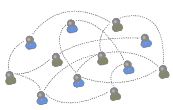Community Embraces New Word Game at Mid-Year Play Day This past Sunday, families at Takoma Park’s Seventh Annual Mid-Year Play Day had the opportunity to experience OtherWordly for the first time. Our educational language game drew curious children and parents to our table throughout the afternoon. Words in Space Several children gathered around our iPads […]
Read moreTag: Twitter
![]() It’s Open Access Week 2012. Now in it’s 6th year, the organizers are promoting Open Access as the new norm in research and scholarship. Here’s a summary of some happenings… (more…)
It’s Open Access Week 2012. Now in it’s 6th year, the organizers are promoting Open Access as the new norm in research and scholarship. Here’s a summary of some happenings… (more…)
Blog bites
October 10th, 2012 by IDEA
Since spring 2010, this blog has covered all kinds of outreach topics, from museums to mobile devices to ebooks to blog networks. The most popular articles have been about strategic communications and QR Codes. These articles were written by Michael Douma, and many were long-form articles, based on multiple interviews or new analysis. Now, we’re going to try something
 The National STEM Video Game Challenge, awarded the $50k grand prize last week to a professional team that did not meet the eligibility criteria.
The National STEM Video Game Challenge, awarded the $50k grand prize last week to a professional team that did not meet the eligibility criteria.
This story came to my attention last week, when I wrote a blog post about a cool online science game for Middle School kids which won the grand prize as part of the contest run by the Joan Ganz Cooney Center at Sesame Workshop (the parent organization of Sesame Street) and E-Line Media. That article briefly mentioned anomalies in the contest, and the Cooney Center sent me an email: “Please take this article down as soon as possible because of a legal issue that is pending.” This made me wonder, is there a scandal on Sesame Street?
 Social media can feel like you are talking to the world, but in reality there’s a lot of self-selection going on. So know your audience.
Social media can feel like you are talking to the world, but in reality there’s a lot of self-selection going on. So know your audience.
Before the Internet, the gatekeepers of public information (journalists, editors and producers) considered the needs of audiences for you. These gatekeepers would filter a fire-hose of information in press releases and technical publications to deliver a digested slivers of information via television news, tv, print, and trade press. Other kinds of technical information was discussed at conferences, at meetings, in journals or in private. (See my post about “Fall of the gatekeepers“) (more…)
 On Twitter, almost no one hears you. Or at least that’s the case for 99.95% of Twitter users whose Tweets evaporate into the aether, scrolling off the feed, leaving scarcely a trace.
On Twitter, almost no one hears you. Or at least that’s the case for 99.95% of Twitter users whose Tweets evaporate into the aether, scrolling off the feed, leaving scarcely a trace.
According to statistics released last week by Twitter, users now send a billion Tweets a week (up nearly 3x from 350M a year ago). But most of those Tweets get little attention, reports a new study, to be presented next week at a web conference in India. The study found that attention is highly concentrated among a very narrow slice of Twitter users. Read on for more about the findings…
(more…)


 So you want to create a niche social network? And you’ve read the
So you want to create a niche social network? And you’ve read the  Thinking about launching a new niche social network for a science or cultural community of professionals? Think again. It costs a lot to do well, and there’s a major risk of failure. People don’t have much time to spend logging into yet another social network, and it’s hard to reach a critical mass so that the site is interesting for people to use.
Thinking about launching a new niche social network for a science or cultural community of professionals? Think again. It costs a lot to do well, and there’s a major risk of failure. People don’t have much time to spend logging into yet another social network, and it’s hard to reach a critical mass so that the site is interesting for people to use. Ravelry
Ravelry